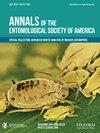四种胰岛素样肽调控绿草蛉的生殖信号(神经翅目:草蛉科)
IF 1.8
3区 农林科学
Q1 ENTOMOLOGY
引用次数: 1
摘要
在昆虫中,胰岛素信号在生长、代谢、繁殖和衰老的调节中起着关键作用。揭示胰岛素信号在天敌昆虫中的调控作用,有助于开发人工促进昆虫繁殖的方法。本研究采用定量实时聚合酶链反应(qRT-PCR)技术分析了天然捕食者黄斑蝶雌性成虫体内4种胰岛素样肽(ILPs)的表达,并采用RNA干扰(RNAi)技术研究了它们的功能。C. pallens ILP1 (CpILP1)和C. pallens ILP4 (CpILP4) mRNA水平从成虫早期到后期逐渐升高。而淡紫色C. pallens ILP2 (CpILP2)和淡紫色C. pallens ILP3 (CpILP3)的表达曲线相反,在成虫期开始时转录量较高,之后逐渐降低。这四种CpILP2在卵巢中均有高表达,但CpILP2转录本在脂肪体中也大量表达。通过rnai介导的敲低破坏CpILP1和CpILP2的表达,显著抑制卵巢发育,并降低淡黄色葡萄球菌卵黄原蛋白基因1 (CpVg1)转录物。CpILP3转录本的缺失没有显著减少卵巢数量,但显著降低CpVg1的表达。干扰CpILP4的表达可显著抑制卵巢发育,但不抑制CpVg1的表达。所有的基因敲低都没有显著地降低总繁殖力和卵子质量。这些数据表明,四种黄颡鱼ILPs在不同程度上参与生殖信号传导。本文章由计算机程序翻译,如有差异,请以英文原文为准。
Four Insulin-Like Peptides Orchestrate Reproductive Signaling of the Green Lacewing, Chrysopa pallens (Rambur) (Neuroptera: Chrysopidae)
Abstract In insects, insulin signaling plays a pivotal role in the regulation of growth, metabolism, reproduction, and aging. Revealing the regulatory roles of insulin signaling in natural enemy insects is helpful for developing artificial approaches to promote reproduction. In this study, the expression of four insulin-like peptides (ILPs) in female adults of the natural predator Chrysopa pallens was analyzed by quantitative real-time-polymerase chain reaction (qRT-PCR) and their functions were investigated by RNA interference (RNAi). C. pallens ILP1 (CpILP1) and C. pallens ILP4 (CpILP4) showed a gradual increase in mRNA levels from early adult stages to later stages. However, C. pallens ILP2 (CpILP2) and C. pallens ILP3 (CpILP3) had an opposite expression curve with a high transcript level at the beginning of the adult stage and a gradual reduction thereafter. All four CpILPs showed high expression levels in the ovary, but CpILP2 transcripts were also abundant in fat bodies. Disruption of CpILP1 and CpILP2 expression by RNAi-mediated knockdown strikingly suppressed ovarian development and reduced C. pallens vitellogenin gene 1 (CpVg1) transcripts. Depletion of CpILP3 transcripts did not significantly decrease ovariole number but drastically reduced CpVg1 expression. Interference with the expression of CpILP4 significantly inhibited ovarian development but did not suppress CpVg1 expression. All gene knockdowns failed to dramatically impair total fecundity and egg quality.These data suggest that the four C. pallens ILPs are involved in reproductive signaling at different degrees.
求助全文
通过发布文献求助,成功后即可免费获取论文全文。
去求助
来源期刊
CiteScore
4.90
自引率
0.00%
发文量
25
审稿时长
6-12 weeks
期刊介绍:
The Annals of the Entomological Society of America exists to stimulate interdisciplinary dialogue across the entomological disciplines and to advance cooperative interaction among diverse groups of entomologists. It seeks to attract and publish cutting-edge research, reviews, collections of articles on a common topic of broad interest, and discussion of topics with national or international importance. We especially welcome articles covering developing areas of research, controversial issues or debate, and topics of importance to society. Manuscripts that are primarily reports of new species, methodology, pest management, or the biology of single species generally will be referred to other journals of the ESA. The most important criteria for acceptance are quality of work and breadth of interest to the readership.

 求助内容:
求助内容: 应助结果提醒方式:
应助结果提醒方式:


